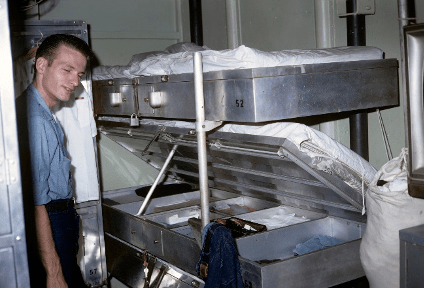210. Enlisted Berthing
On this page:
Location: third Deck

Fast Facts
Sleeping arrangements on board Intrepid varied depending on your rank. Enlisted sailors—most of the crew—slept in packed berthing compartments like this one. This compartment has racks (bunks) and lockers for 33 sailors.

Exhibit Description
Sleeping arrangements on board Intrepid varied depending on your rank. Officers had private quarters or a few roommates. Enlisted sailors slept in berthing compartments located throughout the ship. Typically, sailors bunked with members of their division—other crew members with the same job.
The berthing compartment open to visitors is on third deck, not far from the enlisted mess, where sailors ate. You can look at the room through a glass wall. Each sailor was assigned a rack, the Navy word for a bed. It was very tight sleeping quarters. There could be 60 men berthed in one room.
The racks hang three or four high with little space above or below each one. They’re stacked three high in this room. Each rack consists of a metal frame with stretched canvas in the middle. Each rack holds a thin mattress made up with white sheets and a gray blanket. Each sailor also had one small gray metal locker about two feet square to stow personal things. Sailors also stowed items under their mattress.
These compartments were notoriously hot! No air conditioning in these spaces back then. And since the ship is all steel, it felt like sleeping in an oven in the heat of the Pacific. But over the decades, sailors came up with creative solutions for keeping cool. On quiet nights, some sailors took their bedding to the flight deck to sleep in the open air.
Photos & Videos


More information
This berthing compartment represented typical accommodations for enlisted sailors, who were the vast majority of Intrepid’s crew. When the ship was at sea, around 3,000 men served on board. About 10% of them were officers and the rest enlisted. Most crew members were part of the ship’s company and were assigned to the ship itself. Others served with the squadrons assigned to Intrepid. If Intrepid was designated flagship, the admiral’s staff also served on board.
The number of men on the ship changed from month to month as men joined the crew or were transferred. Crew numbers varied from year to year, depending on the ship’s missions. World War II and Vietnam War crews were larger than peacetime complements.
These numbers represent an average World War II complement:
Ship’s company: 2,040 enlisted 130 officers
Air group: 730 enlisted 140 officers
Flag (admiral’s) staff: 130 enlisted 30 officers
Total: 2,900 enlisted 300 officers
Intrepid’s crew differed from the crews on U.S. Navy ships today. For one thing, women never served on board Intrepid. The U.S. Navy barred women from serving on combat ships until 1994, 20 years after Intrepid’s decommissioning.
Also, today’s Navy is more diverse than it was during Intrepid’s service. For instance, only 5.3% of enlisted sailors were Black in 1971, toward the end of Intrepid’s time in commission. In March 2020, that number was 19.5%.[1]
[1] 1971 statistic from Black Sailor, White Navy. U.S. Navy demographic data from March 31, 2020 states that there were 287,485 people in ratings E1-E9, and 56,109 identify as Black. Did not go into other groups for this purpose but something to research more closely. U.S. Navy data: https://www.navy.mil/strategic/FY20-Q2-Abbreviated-Total-Force-Demographic-Report.pdf